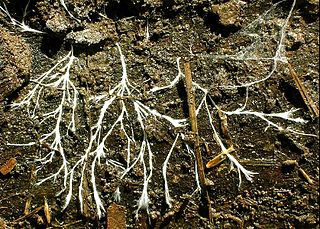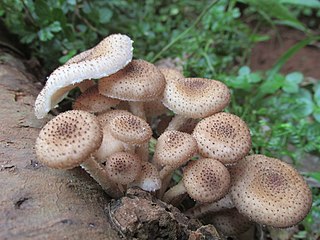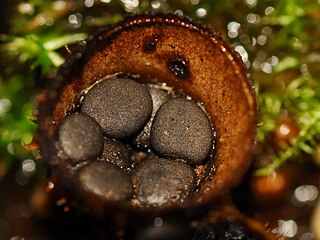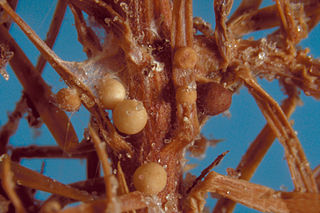
Basidiomycota is one of two large divisions that, together with the Ascomycota, constitute the subkingdom Dikarya within the kingdom Fungi. Members are known as basidiomycetes. More specifically, Basidiomycota includes these groups: agarics, puffballs, stinkhorns, bracket fungi, other polypores, jelly fungi, boletes, chanterelles, earth stars, smuts, bunts, rusts, mirror yeasts, and Cryptococcus, the human pathogenic yeast.

Armillaria is a genus of fungi that includes the A. mellea species known as honey fungi that live on trees and woody shrubs. It includes about 10 species formerly categorized summarily as A. mellea. Armillarias are long-lived and form the largest living fungi in the world. The largest known organism covers more than 3.4 square miles (8.8 km2) in Oregon's Malheur National Forest and is estimated to be 2,500 years old. Some species of Armillaria display bioluminescence, resulting in foxfire.

Armillaria mellea, commonly known as honey fungus, is an edible basidiomycete fungus in the genus Armillaria. It is a plant pathogen and part of a cryptic species complex of closely related and morphologically similar species. It causes Armillaria root rot in many plant species and produces mushrooms around the base of trees it has infected. The symptoms of infection appear in the crowns of infected trees as discoloured foliage, reduced growth, dieback of the branches and death. The mushrooms are edible but some people may be intolerant to them. This species is capable of producing light via bioluminescence in its mycelium.

Rhizoctonia solani is a species of fungus in the order Cantharellales. Basidiocarps are thin, effused, and web-like, but the fungus is more typically encountered in its anamorphic state, as hyphae and sclerotia. The name Rhizoctonia solani is currently applied to a complex of related species that await further research. In its wide sense, Rhizoctonia solani is a facultative plant pathogen with a wide host range and worldwide distribution. It causes various plant diseases such as root rot, damping off, and wire stem. It can also form mycorrhizal associations with orchids.

Mycelial cords are linear aggregations of parallel-oriented hyphae. The mature cords are composed of wide, empty vessel hyphae surrounded by narrower sheathing hyphae. Cords may look similar to plant roots, and also frequently have similar functions; hence they are also called rhizomorphs. As well as growing underground or on the surface of trees and other plants, some fungi make mycelial cords which hang in the air from vegetation.

Armillaria luteobubalina, commonly known as the Australian honey fungus, is a species of mushroom in the family Physalacriaceae. Widely distributed in southern Australia, the fungus is responsible for a disease known as Armillaria root rot, a primary cause of Eucalyptus tree death and forest dieback. It is the most pathogenic and widespread of the six Armillaria species found in Australia. The fungus has also been collected in Argentina and Chile. Fruit bodies have cream- to tan-coloured caps that grow up to 10 cm (4 in) in diameter and stems that measure up to 20 cm (8 in) long by 1.5 cm (1 in) thick. The fruit bodies, which appear at the base of infected trees and other woody plants in autumn (March–April), are edible, but require cooking to remove the bitter taste. The fungus is dispersed through spores produced on gills on the underside of the caps, and also by growing vegetatively through the root systems of host trees. The ability of the fungus to spread vegetatively is facilitated by an aerating system that allows it to efficiently diffuse oxygen through rhizomorphs—rootlike structures made of dense masses of hyphae.

Heterobasidion annosum is a basidiomycete fungus in the family Bondarzewiaceae. It is considered to be the most economically important forest pathogen in the Northern Hemisphere. Heterobasidion annosum is widespread in forests in the United States and is responsible for the loss of one billion U.S. dollars annually. This fungus has been known by many different names. First described by Fries in 1821, it was known by the name Polyporus annosum. Later, it was found to be linked to conifer disease by Robert Hartig in 1874, and was renamed Fomes annosus by H. Karsten. Its current name of Heterobasidion annosum was given by Brefeld in 1888. Heterobasidion annosum causes one of the most destructive diseases of conifers. The disease caused by the fungus is named annosus root rot.

Rigidoporus microporus is a plant pathogen, known to cause white root rot disease on various tropical crops, such as cacao, cassava, tea, with economical importance on the para rubber tree.

Armillaria fuscipes is a plant pathogen that causes Armillaria root rot on Pinus, coffee plants, tea and various hardwood trees. It is common in South Africa. The mycelium of the fungus is bioluminescent.

Cyathus stercoreus, commonly known as the dung-loving bird's nest or the dung bird's nest, is a species of fungus in the genus Cyathus, family Nidulariaceae. Like other species in the Nidulariaceae, the fruiting bodies of C. stercoreus resemble tiny bird's nests filled with eggs. The fruiting bodies are referred to as splash cups, because they are developed to use the force of falling drops of water to dislodge and disperse their spores. The species has a worldwide distribution, and prefers growing on dung, or soil containing dung; the specific epithet is derived from the Latin word stercorarius, meaning "of dung".

Armillaria novae-zelandiae is a species of mushroom-forming fungus in the family Physalacriaceae. This plant pathogen species is one of four Armillaria species that have been identified in Aotearoa New Zealand the others are A. limonea,A. hinnulea, A. aotearoa).

Armillaria gallica is a species of honey mushroom in the family Physalacriaceae of the order Agaricales. The species is a common and ecologically important wood-decay fungus that can live as a saprobe, or as an opportunistic parasite in weakened tree hosts to cause root or butt rot. It is found in temperate regions of Asia, North America, and Europe. The species forms fruit bodies singly or in groups in soil or rotting wood. The fungus has been inadvertently introduced to South Africa. Armillaria gallica has had a confusing taxonomy, due in part to historical difficulties encountered in distinguishing between similar Armillaria species. The fungus received international attention in the early 1990s when an individual colony living in a Michigan forest was reported to cover an area of 15 hectares, weigh at least 9.5 tonnes, and be 1,500 years old. This individual is popularly known as the "humongous fungus", and is a tourist attraction and inspiration for an annual mushroom-themed festival in Crystal Falls. Recent studies have revised the fungus's age to 2,500 years and its size to about 400 tonnes, four times the original estimate.

Armillaria root rot is a fungal root rot caused by several different members of the genus Armillaria. The symptoms are variable depending on the host infected, ranging from stunted leaves to chlorotic needles and dieback of twigs and branches. However, all infected hosts display symptoms characteristic of being infected by a white rotting fungus. The most effective ways of management focus on limiting the spread of the fungus, planting resistant species, and removing infected material. This disease poses a threat to the lumber industry as well as affecting recreational areas.

Armillaria ostoyae is a species of fungus (mushroom), pathogenic to trees, in the family Physalacriaceae. In the western United States, it is the most common variant of the group of species under the name Armillaria mellea. A. ostoyae is common on both hardwood and conifer wood in forests west of the Cascade Range in Oregon, United States. It has decurrent gills and the stipe has a ring. The mycelium invades the sapwood and is able to disseminate over great distances under the bark or between trees in the form of black rhizomorphs ("shoestrings"). In most areas of North America, Armillaria ostoyae can be separated from other species by its physical features: cream-brown colors, prominent cap scales, and a well-developed stem ring distinguish it from other Armillaria. Like several other Armillaria, the mycelium of Armillaria ostoyae can display bioluminescence, resulting in foxfire.

The Nidulariaceae are a family of fungi in the order Agaricales. Commonly known as the bird's nest fungi, their fruiting bodies resemble tiny egg-filled birds' nests. As they are saprobic, feeding on decomposing organic matter, they are often seen growing on decaying wood and in soils enriched with wood chips or bark mulch; they have a widespread distribution in most ecological regions. The five genera within the family, namely, Crucibulum, Cyathus, Mycocalia, Nidula, and Nidularia, are distinguished from each other by differences in morphology and peridiole structure; more recently, phylogenetic analysis and comparison of DNA sequences is guiding new decisions in the taxonomic organization of this family.

Helicobasidium is a genus of fungi in the subdivision Pucciniomycotina. Basidiocarps are corticioid (patch-forming) and are typically violet to purple. Microscopically they have auricularioid basidia. Asexual anamorphs, formerly referred to the genus Thanatophytum, produce sclerotia. Conidia-bearing anamorphs are parasitic on rust fungi and are currently still referred to the genus Tuberculina.

Serpula himantioides is a species of fungus that causes damage to timber referred to as dry rot. It is a basidiomycete in the order Boletales. It has been found on all continents except for Antarctica. Recent molecular work demonstrates that S. himantioides is a species complex including multiple cryptic lineages.

Agroathelia rolfsii is a corticioid fungus in the order Amylocorticiales. It is a facultative plant pathogen and is the causal agent of "southern blight" disease in crops.

















